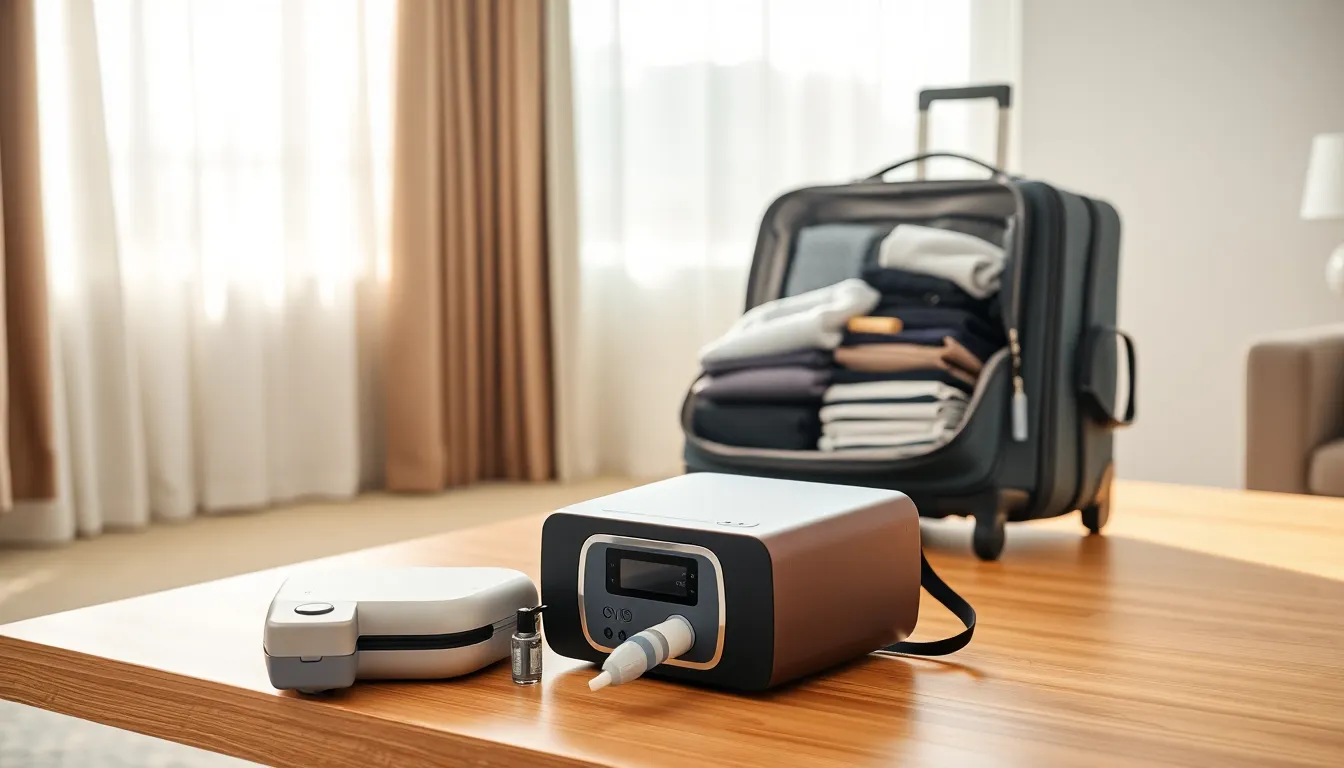Table of Contents
ToggleImagine this: you’re gearing up for that long-awaited vacation, sunglasses on, bags packed, and suddenly, it hits you, you can’t leave without your CPAP machine. But then, dread washes over you. How will it fit in your luggage? Will it work in that tiny hotel room? Fear not. Portable CPAP machines are here to make your travels smooth and snore-free. In this guide, we’ll jump into the world of these travel-friendly devices, breaking down everything you need to know while keeping some chuckles along the way.
Understanding Portable CPAP Machines

Portable CPAP machines are compact devices designed to help people with sleep apnea enjoy restful sleep, no matter where they are. Unlike traditional CPAP machines, which can feel like lugging around a small animal, portable options are lightweight and easy to transport. They typically weigh less than five pounds and are often designed to fit into carry-on luggage.
These travel-friendly machines can operate on batteries, making them perfect for camping trips or stays in hotels without easy access to power outlets. Plus, many recent models have quieter motors, so they won’t keep you or your travel companions up at night. Horror movies may have trained us to fear the sound of machinery, but with a portable CPAP, that’s not an issue.
For those frustrated by the constraints of bulky equipment, portable CPAP machines offer the freedom to roam, without sacrificing sleep. By utilizing cutting-edge technology, they ensure users can keep their therapy accessible even on the move.
Benefits Of Using A Portable CPAP On The Go
Taking a portable CPAP on your travels yields a treasure trove of benefits. The most crucial one? It keeps sleep apnea symptoms at bay. For many, missing a night’s CPAP therapy is a recipe for disaster, think grogginess, headaches, and crankiness on the first day of vacation. Ain’t nobody got time for that.
Also, they help maintain a consistent sleep schedule. Whether you’re traveling across time zones or exploring new cities, your sleep routine can be thrown into disarray. A portable CPAP ensures that your body can continue to enjoy its nightly routine, helping to minimize jet lag.
Also, portability means fewer worries. Reduced stress when traveling allows one to focus on experiencing all the new adventures the world has to offer. As you pack those swim trunks and hiking boots, you can feel confident knowing your sleep needs are covered.
Plus, many machines come equipped with convenience features like built-in humidifiers, ideal for those dry hotel rooms. Think of it as the Swiss army knife of sleep therapy.
Key Features To Look For In A Portable CPAP
Selecting the right portable CPAP machine requires paying attention to several key features, after all, not all CPAPs are born equal. Here’s a checklist to guide your decision:
- Size and Weight: Look for something compact. Many brands design their machines to fit nicely in a carry-on. Nobody wants to lug a bulky device around the airport.
- Battery Life: For those adventurous souls who might travel off the beaten path, a machine with a long battery life is essential. Check whether it can be charged in your car or comes with an additional battery option.
- Noise Level: A quiet machine is a must for both you and your travel companions. Some portable machines operate at whisper levels, ensuring peaceful nights in shared accommodations.
- Humidification: A built-in humidifier can help combat the dryness of cabin air or hotel rooms, making your experience smoother.
- User-Friendliness: Look for features that simplify your user experience, such as easy setup, clear display screens, and simple controls.
With the right model, travel doesn’t have to be a hassle, even if you require specialized sleep therapy.
Tips For Traveling With Your CPAP Machine
Traveling with a CPAP doesn’t have to be complicated. Here are some handy tips to make life easier:
- Pack Smart: Always pack your CPAP in your carry-on luggage. Checked luggage can get lost, and the last thing you want in a foreign country is a sleepless night without your trusty machine.
- Notify Security: Let TSA agents know you have a medical device during screening. They usually understand and will help the process.
- Bring Extra Supplies: Don’t skimp on replacement parts. Bringing extra filters, hoses, and masks ensures that you’re ready for anything.
- Read the Manual: The instructions for your CPAP might differ when traveling. Make sure to familiarize yourself with how it operates on different power sources.
- Check Voltage Compatibility: If you’re traveling internationally, check if your CPAP needs a voltage converter. Some machines are designed to work with worldwide voltages, eliminating the hassle of adapters.
Maintaining Your Portable CPAP While Traveling
Proper maintenance is key to keeping your portable CPAP in top shape, especially while on the move. Here are some essential maintenance tips:
- Clean Regularly: After each use, clean your mask and tubes. It’s as simple as rinsing with warm, soapy water. Consider packing travel-sized cleaning supplies to stay on top of this.
- Check for Damage: Before departing for your trip, ensure there’s no damage to your equipment. Cracks or worn-out parts can lead to leaks, making your machine less effective.
- Change Filters: Certain CPAP machines have filters that need to be changed regularly. Keep spares on hand to avoid interruptions during your trip.
- Store Properly: Use protective cases or bags to keep your CPAP secure during transport. Nobody wants to open their luggage to find a shattered device.
- Hydrate: If your CPAP has a humidifier, always fill it with distilled water. Tap water might produce harmful minerals that could affect your device.
Comparing Popular Portable CPAP Models
When it comes to choosing a portable CPAP machine, consumers have a wide array of options. Here’s a brief look at some popular models that may suit diverse needs.
- ResMed AirMini: Known for its compact design, the AirMini is light and has built-in humidity options. Its ease of use makes it a favorite among travelers.
- Philips DreamStation Go: This model is particularly well-regarded for its sleek aesthetics and quiet operation, ensuring minimal disturbance. It also boasts a USB charging port for added convenience.
- Z1 Auto CPAP: The Z1 is another lightweight option that comes with a battery pack, making it a top choice for outdoor enthusiasts. It emphasizes simplicity without needless bells and whistles.
- LIVE active: A more recent player on the market, the LIVE active focuses on advanced features and user-friendly connectivity with apps, appealing to tech-savvy travelers.
By evaluating the specific needs and portability options, users can find a model tailored to their lifestyle.





